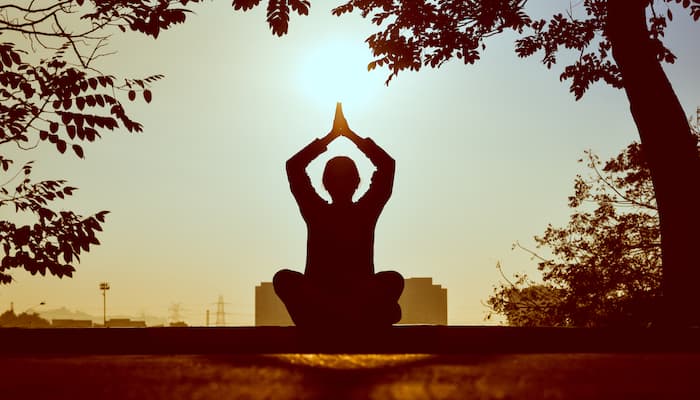Article: Breathing through Discomfort: What Yoga Taught me about Depth Hypnosis
By Denise Colby, Ph.D.
“Yoga saves your life.” It was my trademark phrase around the yoga studio, and what I offered to anyone who asked for my opinion on the practice. In my nearly 20 year engagement with yoga, I’ve found the practice to influence and mirror just about every aspect of life off the mat. Like my relationship to Depth Hypnosis, it started out as a tool I engaged with for a particular purpose and eventually became a way of life. These two practices weave themselves together into a beautiful tapestry of healing and transformation for this very corporeal, very human experience that we are all having. What I have found over the years is that there’s a lot of Depth Hypnosis in yoga, and a whole lot of yoga in Depth Hypnosis. A mindful dedication to this combination of practices creates a powerful vehicle of transformation to support the healing process.
In Depth Hypnosis, we are deeply engaged with the process of encountering ourselves in all of our darkest spaces. The shadow self is bravely and compassionately explored so that we can heal our trauma and unwind the false beliefs and patterns that we have held about ourselves and reality for much of our lives. Depth Hypnosis is a somatic practice that addresses trauma or energetic imbalance through the body itself, ultimately re-wiring our circuitry to bring about understanding and peace in our past and current experience. For those who have suffered bodily trauma or other experiences that have made the body feel like an unsafe place to be, a significant piece of the work of Depth Hypnosis is simply reestablishing safety and connection to the body. This is no small feat.
This work of returning to the body, of learning to trust and listen, is where a yoga practice can dramatically augment and catalyze the work of Depth Hypnosis. Whether we are aware of it or not, every time we step onto the mat with an intention of integrity and wellness, we are doing the work of repairing the relationship of the mind with the body. And as anyone who’s ever been in any relationship can tell you: the work of repairing begins and ends with listening. The practice of yoga is inherently a practice of turning inward and learning the language of your body.
Yoga is a whole cluster of dichotomies. It is simple and complicated. Effortful and easeful. Physical and mental. Hard and soft. This is one of its many “tricks.” Just when you think you understand your practice, it shifts into something else, revealing a facet of yourself that is both magical and at times confounding. In Depth Hypnosis, the Eriksonian redirect is often used to break up the mind’s natural tendency to take over and try to predict what is coming next. This disruption leads to a deepening into the subconscious realm. Yoga is full of redirects! Just when you think you know what’s coming, it gives you a little curveball that takes you deeper into yourself.
For the initiate, the early practice of yoga is mostly one of proprioception. Yoga looks complicated. You are asked to assume any number of shapes, sometimes in quite rapid succession, and you have to sort out how to get your body parts into the right places. Next comes an array of very subtle yet vital shifts in body positioning and muscular engagement so that the shape can be held with integrity. A lack of integrity can lead to injury, and so this is an important stage. You might find yourself really pushing yourself; holding your breath and clenching your jaw in order to use just the right muscles in just the right way. Of course, this is always the moment where your instructor pipes up and reminds you that you ought to be breathing and easeful or it isn’t yoga! And so you exhale…
It may take you 5 or 25 yoga classes to get to this point, but here yoga has revealed to us the first of many gems. You’ve pushed yourself a bit. You put in the hours figuring out where to put your hands and feet. You’ve built up a little bit of strength. Prior to this moment, you couldn’t possibly focus on the breath because you’ve needed all of your awareness just to organize this body. But here you are, finally at a place where you can ask yourself to go one step further and actually breathe in this complicated and sometimes not very comfortable shape. This is where the magic truly begins.
This first exercise in proprioception cannot be understated in the therapeutic process. For those who have suffered bodily trauma or have otherwise learned that the body is not trustworthy, there is often a degree of dissociation from the body. This loss of body awareness can range from quite subtle to so extreme that even gross physical sensations cannot be felt without some effort or visual cues. So the simple act of aligning the body in a particular way in space is for many the beginning of a relationship to body awareness as a benign experience.
I know that many would disagree with me on this point, but from personal experience, I have found a mirror to be extremely helpful in this stage of a yoga practice. The mirror showed me what I could not feel. Without the mirror I was blind to the gross disparity between my perception and reality. The mirror helped me to establish a firm reality of my body in space. To connect the feelings of movement and alignment to the actuality of movement and alignment. In this stage of the yoga practice, you are laying down new neural networks connecting perception to the physicality of your body with a neutral emotional backdrop. The importance of this is truly paramount if one wishes to be free of physically held trauma.
The second stage is the breath. One could write, and many have, entire volumes on the intricate importance of the breath in self-regulation and awareness. We will keep it fairly simple here, but the breath is truly the gateway to the regulation of the nervous system. Breathing seems so simple and obvious; it happens with or without our input every moment of every day from the time we are born until the moment we die. But if you really tune into your breath throughout the day, without trying to influence it in any way, you will begin to notice that the quality of breath changes quite dramatically depending on what the body is experiencing. The breath is intimately linked to the nervous system. Taking this even further, it has been shown that by influencing the breath, you can actually change the experience the nervous system is having. It is a two-way street. This is remarkable, and awareness of this truth is the beginning of mastery over your emotions and reactivity.
Returning again to the moment in that yoga class where you’ve finally arranged your body in space and received the cue to breathe. As you take that step – to breathe, slowly and evenly even as your body is exerting quite a lot of effort – you will notice something remarkable happen almost immediately. Your heart rate slows down, your jaw loosens, and your mind softens as your practice suddenly expands to include just a little bit of ease. Everything shifts. The more you can focus on the breath while practicing, the more your body opens to the shape it’s taking. Suddenly a shape that required quite a bit of struggle to hold can be held with ease and just as much integrity. This is the gift of yoga as one encounters trauma and shadow aspects of the self within a healing modality such as Depth Hypnosis. To breathe and rest into your own integrity, even as you experience discomfort and struggle. If we can do this, what we find is that the discomfort and struggle often quite naturally fall away, and we are left standing in our strength.
I used to frequently say to my classes, “If I could teach all of you just one thing, this is the thing I would teach you: To learn how to breathe through discomfort. Many of our negative habits – the alcohol, drugs, food, sex, or screens – would not have so much hold over us if we could meet physical and emotional discomfort in a calm and breath-filled way.” For me, this was the most life-changing aspect of yoga, and the discovery that truly transformed my experience of yoga, Depth Hypnosis, and life. In this stage of practice, you are learning that not only is the body a safe place, but that you can allow and abide by any sensation that the body presents you with. You can make your breath bigger than the sensation. This is crucial in the work of fully recovering from trauma.
In Depth Hypnosis, trauma is addressed by revisiting the moment of distress in a very well-resourced way. You meet the distressed self as your wiser, current self, equipped with at least one compassionate guide to help bring healing and clarity to the process. As a somatic process, Depth Hypnosis involves reexperiencing some degree of the visceral sensations encountered in the moment of trauma. This is a pivotal moment in healing because you are revisiting the source of trauma and reexperiencing the feelings, but this time in a clear and resourced way that brings understanding and healing. This is the work of repatterning the body and neural network to have a different response to the various traumatic stimuli, thus permanently altering your experience of yourself and reality. This is why Depth Hypnosis is so thorough and enduring relative to other approaches.
When the degree of trauma is severe, or the separation of awareness from the body is especially acute, the ability to track and stay with the visceral sensations can be challenging. These clients must first learn to feel supported and safe as uncomfortable feelings are encountered. Consistent engagement through benign experiences with the guide will cultivate this safety, but this is where a yoga practice has the potential to really deepen and catalyze the Depth Hypnosis practice. Through yoga, one learns how to breathe and be at ease, even in the midst of discomfort and struggle. The body becomes trustworthy and safe. A tolerance for uncomfortable sensations and emotions is established and expands. There is a gentle allowing and acceptance of yourself as just as you are today, in this moment. This is the acceptance that is required if we truly wish to change.
The truth that I have come to live is that yoga and Depth Hypnosis are woven from the same tapestry. The practitioner is your mirror, aligning perceptions with reality. Your mind navigates an emotional landscape as you twist and turn with agility and strength through the process. You learn how to rest in your effort and be supported by your integrity. Each time you close your eyes and connect with your inner guidance, you are “rolling out the mat” and strengthening your connection with yourself. It is this braiding together of the physical, mental, emotional, and spiritual experience that makes these methods so unifying and supportive of one another. These powerful practices will allow you to stand in your strength and show up for yourself and your life with grace and dignity.
Denise Colby is a certified Depth Hypnosis Practitioner in San Francisco, CA. She holds a doctorate degree in Chemistry from the University of California, Berkeley, and spent several years working in the biotech industry while pursuing studies and certifications in yoga, Depth Hypnosis, and energy healing. Her scientific background combines with a holistic approach to treating the mind, body, and spirit to create a patient and pragmatic approach to healing. Her work is rooted in a deep and compassionate understanding of the coping mechanisms and behavioral adaptations that arise from the difficult circumstances encountered in childhood and throughout life. You can visit Denise’s website to learn more about her practice.
LIKE THIS ARTICLE? SIGN UP FOR FREE UPDATES!



